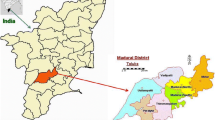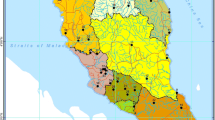Abstract
Investigation of drought event has a great importance in the natural resources management and planning water resources management. One strategy to manage drought is to predict drought conditions by probabilistic tools. In this study climate data of 11 synoptic stations in south of Iran during 1980–2014 were used to estimate of seasonal drought based on RDI index. To prediction of drought (from 2015 to 2020) and analysis of changes trend of it, time series model, first-order Markov Chain model and parametric and non- parametric statistical methods were used. Results showed that MA (5), MA (10), AR (12) and AR (15) were the best time series models that fitted in data of all stations. According to results of prediction of drought classes, classes with normal and moderate dry condition had allocated the most frequency of seasonal drought classes from 2015 to 2020 based on time series model and Markov Chain method. Analysis of changes trend of drought classes showed that based on observed data (1980–2014) and predicted data (1980–2020) changes trend of drought classes in all stations had increasing trend based on parametric and non- parametric statistical methods but increasing trend in about 27% of stations include: Bandar Abbas, Bandar Lengeh, Jask and Shiraz had significant level of 5%. Finally result showed that the study area in 2020 compared to 2014 will be drier.









Similar content being viewed by others
References
Abdulrahim M, Fabiyi P, Ismaila A (2013) Time series analyses of mean monthly rainfall for drought management in Sokoto, Nigeria. Ethiop J Environ Stud Manag 6(5):461–470
Anil KR, Indira H (2007) Multiple impacts of droughts and assessment of drought policy in major drought Prone States in India. The Planning Commission, Government of India, New Delhi
Azhdari MM, Khosravi M, Hosseinpour NH, Jafari NE (2012) Drought forecasting using neuro-fuzzy model, climate indices and time series of precipitation and drought case study: Zahedan-Iran. Geogr Dev 10(26):17–20
Bashirzadeh M, Araghynejad S (2010) Forecasting severity, duration and frequency of droughts using Markov Chain and run theories (case study: Lorestan province). Iran Water Res J 4(6):91–94
Brockwell PJ, Davis RA (2016) Introduction to time series and forecasting. Springer
Dabral PP, Murry MZ (2017) Modelling and forecasting of rainfall time series using SARIMA. Environ Process 4(2):399–419
Dastorani M, Mirzavand M, Dastorani MT, Sadatinejad SJ (2016) Comparative study among different time series models applied to monthly rainfall forecasting in semi-arid climate condition. J Nat Haz. https://doi.org/10.1007/s11069-016-2163-x
Ghabaei SM, Mosaedi A (2014) Modification of reconnaissance drought index (RDI) based on the best methods of evapotranspiration estimation and probability distribution function. J Range Watershed Manag (Iran J Nat Resour) 66(4):565–582
Gui Y, Shao J (2017) Prediction of precipitation based on weighted Markov Chain in Dangshan, Proceedings of the International Conference on High Performance Compilation, Computing and Communications, 81–85
Jahandideh M, Shirvani A (2012) Drought forecasting based on the standardized precipitation index using time series models in Fars province. Iran Water Res J 5(9):19–27
Karthika M, Krishnaveni, Thirunavukkarasu V (2017) Forecasting of meteorological drought using ARIMA model. Indian J Agric Res 51(2):103–111
Kohler MA (1949) Double-mass analysis for testing the consistency of records and for making adjustments. Bull Am Meteorol Soc 30:188–189
Mghadam V, Jamali J, Javanmard S, Mahdeyan A & Khazanedari L (2000) Drought monitoring based on SPI index, decade index and normal index in Sistan Balochestan Province, Proceedings of First Conference in Zabul investigate ways to deal with the water crisis 3: 69–80
Moghaddam YJ, Saradjian MR, Forati AM (2017) A probability model for drought prediction using fusion of Markov Chain and sax methods, The International Archives of the Photogrammetry, Remote Sensing and Spatial Information Sciences, Volume XLII-4/W4, 2017 Tehran's Joint ISPRS Conferences of GI Research, SMPR and EOEC 2017, 7–10
Mosaedi A, Eivazi M (2008) identification and prediction of some drought characteristics in Golestan province, using Markov Chain. Agricul Res 8(1):89–99
Mosaedi A, Ghabaei SM (2011) Modification of standardized precipitation index (SPI) based on relevant probability distribution function. J Water Soil (Agric Sci Technol) 25(5):1206–1216
Raziei T, Daneshkar Arasteh P, Akhtari R, Saghafian B (2007) Investigation of meteorological droughts in the Sistan and Balouchestan province, using the standardized precipitation index and Markov Chain model. Iran Water Resour Res 3(7):25–35
Salajegheh A, Fathabadi A, Najafi HM (2008) Comparison of application time series and artificial neural network models in drought forecasting (case study: Khorasan Razavi provinces) indices. Iran J Watershed Manag Sci Eng 2(4):74–77
Shaari MA, Samsudin R, Shabri Ilman AB (2017) Comparison of drought forecasting using ARIMA and empirical wavelet Transform-ARIMA, International Conference of Reliable Information and Communication Technology IRICT 2017: Recent Trends in Information and Communication Technology, 449–458
Shamsnia A, Pirmoradian N, Amiri N (2009) Drought modeling in Fars Province using time series analysis. J Geogr Plan 14(28):165–189
Sheng H, Chen YQ (2011) ARIMA with stable innovations model of Great Salt Lake elevation time series. Signal Process 91:553–561
Sneyers R (1990) On the statistical analysis of series of observations. World Meteorological Organization, Technical Note No. 143, WMO No. 415
Tavousi T, Khosravi M, Ghaderi Zeh K (2010) Assessment of drought and trends analysis of short-duration dry periods in Iran Shahr region, using a Markov Chain (1980-2006). Environ Sci 7(4):31–44
Tsakiris G (2004) Meteorological drought assessment. Paper prepared for the needs of the European Research Program MEDROPLAN (Mediterranean Drought Preparedness and Mitigation Planning), Zaragoza, Spain
Tsakiris G, Vangelis H (2005) Establishing a drought index incorporating evapotranspiration. Eur Water 9(10):3–11
Tsakiris G, Rossi G, Iglesias A, Tsiourtis N, Garrote L, Cancelliere A (2006) Drought Indicators Report. Report made for the needs of the European Research Program MEDROPLAN (Mediterranean Drought Preparedness and Mitigation Planning)
Tsakiris G, Pangalou D, Tigkas D, Vangelis H (2007) Assessing the areal extent of drought. Water resources management: new approaches and technologies, European water resources association, Chania, Crete -Greece, 14–16 June
Tsakiris G, Nalbantis I, Pangalou D, Tigkas D, Vangelis H (2008) Drought meteorological monitoring network design for the Reconnaissance Drought Index (RDI), 1st International Conference “Drought Management: Scientific and Technological Innovations”. Zaragoza – Spain
Tsakiris G, Nalbantis I, Cavadias G (2011) Regionalization of low flows based on canonical correlation analysis. Adv Water Resour Manag 34:865–872
Tsakiris G, Nalbantis I, Vangelis H, Verbeiren B, Huysmans M, Tychon B, Jacquemin I, Canters F, Vanderhaegen S, Engelen G, Poelmans L, Becker P, Batelaan O (2013) A system-based paradigm of drought analysis for operational management. Water Resour Manag 27:5281–5297
Vangelis H, Tigkas D, Tsakiris G (2013) The effect of PET method on reconnaissance drought index (RDI) calculation. J Arid Environ 88:130–140
Wilhite DA, Glantz MH (1985) Understanding the drought phenomenon: the role of definitions. Water Int 10:111–120
Wilhite DA, Hayes MJ, Svodoba MD (2000) Drought monitoring and assessment in the U.S. In: Voght JV, Somma F (eds) Drought and drought mitigation in Europe. Kluwers, Dordrecht
Wilks DS (2011) Statistical methods in the atmospheric sciences, 3rd edn. Academic Press, Cambridge
Yousefi N, Hajam S, Irannezhad P (2007) Estimating probabilities of drought and wet periods using the Markov Chain and normal distribution methods: case study Ghazvin. Geogr Res Q 39(60):121–128
Zandi LH, Fooladmand H, Boustani F (2014) Evaluation of the wheat agricultural drought return period in the province of Fars using RDI index. Water Eng 7(22):1–10
Zarei AR, Moghimi MM, Mahmoudi MR (2016a) Analysis of changes in spatial pattern of drought using RDI index in south of Iran. Water Resour Manag 30(11):3723–3743
Zarei AR, Moghimi MM, Mahmoudi MR (2016b) Parametric and non-parametric trend of drought in Arid and Semi-Arid Regions using RDI Index. Water Resour Manag 30:5479–5500
Zarei AR, Moghimi MM, Bahrami M, Mahmoudi MR (2016c) Evaluation of changes trend in seasonal drought based on actual data (1980-2014) and predicted data (1980-2019) in south-west of Iran. Desert Manag 7:71–85
Zarei AR, Moghimi MM, Mahmoudi MR (2016d) Modeling and prediction of seasonal drought, using RDI index and time series models (Case study: Tehran synoptic station). Desert Ecosyst Eng 5(11):105–116
Acknowledgements
Author of this paper would like to thank national water organization and meteorological organization of Iran for providing the meteorological data.
Author information
Authors and Affiliations
Corresponding author
Rights and permissions
About this article
Cite this article
Zarei, A.R. Evaluation of Drought Condition in Arid and Semi- Arid Regions, Using RDI Index. Water Resour Manage 32, 1689–1711 (2018). https://doi.org/10.1007/s11269-017-1898-9
Received:
Accepted:
Published:
Issue Date:
DOI: https://doi.org/10.1007/s11269-017-1898-9




